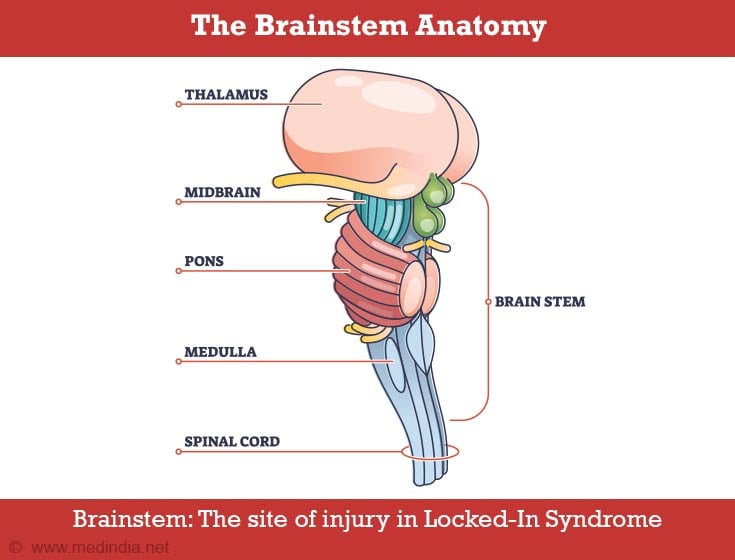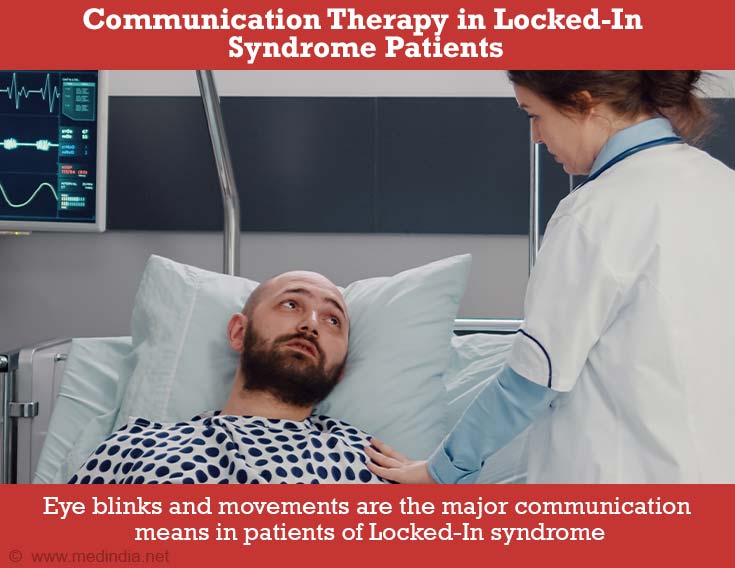- Locked-in Syndrome (LiS) - (https://my.clevelandclinic.org/health/diseases/22462-locked-in-syndrome-lis)
- Varieties of the locked-in syndrome - (https://pubmed.ncbi.nlm.nih.gov/92545/)
- Locked in Syndrome - Diagnosis - (https://rarediseases.org/rare-diseases/locked-in-syndrome/#diagnosis)
- Locked-in Syndrome (LiS) - (https://brainfoundation.org.au/disorders/locked-in-syndrome-lis/)
Locked-in Syndrome: Disease Overview
Locked-in syndrome (LiS) is a rare neurological disorder characterized by the paralysis (complete or partial loss of muscle function) of all the muscles of the body that control movement, except for the eye muscles. First introduced in 1966 by Plum and Posner, the term "locked-in syndrome" refers to paralyzed patients who are conscious, alert, can blink their eyes and make purposeful eye movements. They have an intact ability to reason and can think normally. However, they’re unable to show facial expressions, speak or move. People with LiS can hear and can also use assistive technologies, such as speech generating devices, communication boards etc. to communicate with the people around them.
Locked-in Syndrome: Causes and Types
Locked-in syndrome, also known as Pseudocoma or De-efferented state, is a rare condition caused by damage to a specific part of the brainstem called the pons. The pons is an important group of nerve fibers that connects the lower part of the brainstem (medulla oblongata) to a part of the brain called the cerebellum, which controls physical movement and coordination.
When someone has locked-in syndrome, the pons gets injured, and this leads to damage to all the nerves that run from the brain, through the spinal cord, and to the muscles of the body. As a result, the person becomes paralyzed and loses the ability to make facial expressions, chew, swallow, and talk(1✔ ✔Trusted Source
Locked-in Syndrome (LiS)
Go to source).
Several specific conditions and situations cause locked-in syndrome. The most common cause is stroke which is the interruption of the blood supply to the brainstem either because of a clot (ischemic) or because of a hemorrhage.

Other causes include:
- Infection
- Trauma
- Brainstem tumors
- Demyelination syndromes which result in the loss of the protective insulation (myelin) of the nerves
- Certain diseases like Amyotrophic lateral sclerosis (ALS) and Guillain-Barre syndrome.
Bauer described three categories of List(2✔ ✔Trusted Source
Varieties of the locked-in syndrome
Go to source) -
- Complete or total LiS: Quadriplegia (no body movement) and anarthria (inability to speak). No eye movement
- Classic LiS: Preserved vertical eye movement and blinking
- Incomplete LiS: Recovery of some voluntary movements in addition to eye movements
How is Locked-in Syndrome Diagnosed?
Diagnosis of locked-in syndrome is usually made clinically along with several neurological tests to differentiate them from other similar conditions.
- Magnetic Resonance Imaging (MRI) Brain: This imaging modality helps to identify the area of the brain affected.
- Magnetic Resonance Angiography (MRA): It is used to review the arteries of the brainstem for any clot or hemorrhage.
- An Electroencephalogram (EEG): An EEG measures the electrical activity of the brain. Patients with locked-in syndrome reveal normal brain activity and sleep-wake cycles.
- Evoked Potentials Tests: These tests look for the brain activity in response to a stimulation (pain or auditory or visual).
- Electromyography and nerve conduction study: These tests help to identify and assess the injury to the muscles and nerves(3✔ ✔Trusted Source
Locked in Syndrome - Diagnosis
Go to source).
Treatment for Locked-in Syndrome
There is no specific cure treatments for locked-in syndrome. Treatment of the cause and prevention of further complication remains the mainstay of treatment. Management strategies include the following:
- Supportive therapy: Supportive therapy for breathing using an airway tracheostomy tube along with a Ryles/ Gastrostomy tube for feeding the patient are of utmost importance.
- Rehabilitation: It aims at prevention of complications due to immobilization and pressure injuries (bedsores) along with providing physical therapy to prevent limb contractures (muscle or soft tissue stiffness).

- Communication training: Speech therapists can help patients to communicate more effectively with eye movements and blinking.
- Augmentative and Alternative Communication technology: Communication devices such as infrared eye movement sensors and computer voice prosthetics, allow people with locked-in syndrome to communicate more freely(4✔ ✔Trusted Source
Locked-in Syndrome (LiS)
Go to source).
Prognosis of Locked-in Syndrome
Depending on the cause of locked-in syndrome (LiS), many patients may recover some percentage of their movement and sensation in certain areas of their body. However, a complete recovery is highly unlikely. It has been noted that despite significant disability, affected individuals can and often do have a good quality of life. However very few reach a level of recovery enabling them to perform activities of daily living independently.





